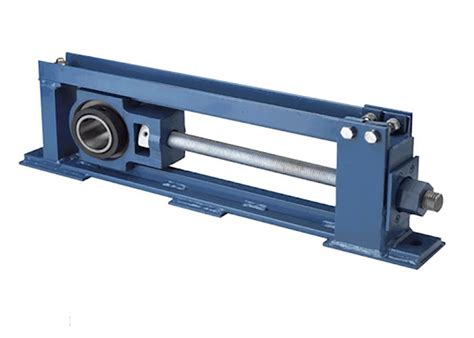Take Up Bearing: A Comprehensive Guide to Enhance Belt Conveyor Performance
Introduction
Take-up bearings play a crucial role in belt conveyor systems, ensuring optimal belt tension, supporting the belt, and preventing misalignment. Proper take-up bearing selection, installation, and maintenance are essential for maximizing conveyor efficiency, minimizing downtime, and extending equipment lifespan. This comprehensive guide provides in-depth insights into all aspects of take-up bearings, empowering you to optimize your conveyor operations.
Understanding Take-Up Bearings
Take-up bearings are mechanical devices that provide adjustable support for conveyor belts, maintaining the desired tension and alignment. They consist of a bearing housing, a shaft, and a take-up screw mechanism. The bearing housing supports the belt, while the shaft allows the take-up screw to move linearly, adjusting the belt tension.
Functions of Take-Up Bearings
Take-up bearings perform several critical functions:


-
Maintain Belt Tension: They ensure the belt is running at the correct tension, preventing slippage, stretching, and damage.
-
Support the Belt: Take-up bearings provide support to the belt, preventing it from sagging or buckling under load.
-
Prevent Misalignment: By adjusting the belt tension, take-up bearings help keep the belt aligned, preventing edge wear and premature failure.
-
Facilitate Belt Tracking: They assist in keeping the belt centered on the conveyor, preventing it from running off the rollers.
Types of Take-Up Bearings
There are various types of take-up bearings available, each with its unique advantages and applications:
-
Screw Take-Up Bearings: Manual or motorized, these bearings use a screw mechanism to adjust the belt tension.
-
Gravity Take-Up Bearings: Utilizes gravity to adjust the belt tension, making them suitable for applications with low tension requirements.
-
Hydraulic Take-Up Bearings: Provides automatic tension adjustment using hydraulic pressure, ensuring precise control.
-
Pneumatic Take-Up Bearings: Employs compressed air to adjust the belt tension, offering fast and responsive control.
Selecting the Right Take-Up Bearing
Proper take-up bearing selection is essential for optimal performance. Consider the following factors:
-
Conveyor Belt Type and Width: Different belt types and widths require specific take-up bearing capacities.
-
Loading Conditions: The expected load on the belt will determine the required bearing capacity and design.
-
Conveyor Speed: Higher conveyor speeds demand more robust bearings with reduced friction.
-
Environmental Conditions: Exposure to moisture, dust, or extreme temperatures may require specialized bearing materials or protective coatings.
Installing Take-Up Bearings
Proper installation is crucial to ensure proper functionality and longevity:

-
Mount the Bearing: Secure the bearing housing to the conveyor frame using suitable fasteners.
-
Set the Belt Tension: Follow the manufacturer's instructions to adjust the belt tension using the take-up screw.
-
Lubricate the Bearing: Apply appropriate lubrication to the bearing as per the manufacturer's recommendations.
Maintaining Take-Up Bearings
Regular maintenance is essential to minimize downtime and extend bearing life:
-
Inspect Regularly: Perform visual inspections regularly to check for wear, damage, or misalignment.
-
Lubricate as Needed: Replenish lubrication as per the manufacturer's recommended intervals.
-
Check Belt Tension: Ensure the belt tension remains within the specified range to prevent excessive wear or slippage.
-
Replace Bearings When Necessary: Replace bearings when they exhibit signs of excessive wear, excessive noise, or reduced performance.
Troubleshooting Take-Up Bearing Issues
Common take-up bearing issues and their solutions include:
-
Belt Slippage: Adjust the belt tension using the take-up screw.
-
Excessive Noise: Lubricate the bearing or replace it if it is worn.
-
Alignment Problems: Check the conveyor frame and rollers for misalignment and correct as necessary.
-
Bearing Failure: Replace the bearing immediately to prevent further damage.
Effective Strategies
-
Use High-Quality Bearings: Invest in durable, reliable bearings from reputable manufacturers to ensure longevity and minimal maintenance.
-
Optimize Tension Adjustment: Fine-tune the belt tension to prevent excessive stretching or wear while maintaining optimal performance.
-
Automate Tension Control: Consider using hydraulic or pneumatic take-up bearings for automatic tension adjustment, especially in critical applications.
Tips and Tricks
-
Use Anti-Friction Bearings: Choose bearings with low friction coefficients to minimize energy loss and extend bearing life.
-
Protect from Corrosion: Use stainless steel or galvanized bearings in corrosive environments to prevent premature failure.
-
Monitor Bearing Temperature: Install temperature sensors on bearings to detect excessive heat and prevent damage.
How-to Step-by-Step Approach
Installing a Screw Take-Up Bearing:
- Mount the bearing housing to the conveyor frame.
- Insert the take-up screw into the bearing housing.
- Engage the take-up screw with the belt.
- Adjust the belt tension using the take-up screw.
- Lock the take-up screw in place.
Case Studies
Story 1:
A mining operation experienced frequent belt slippage due to inadequate take-up bearing tension. They installed a hydraulic take-up bearing with automatic tension adjustment. The new bearing effectively maintained optimal tension, eliminating slippage and minimizing belt wear.

Story 2:
A manufacturing plant faced premature bearing failure due to exposure to corrosive chemicals. They replaced the bearings with stainless steel bearings, which significantly extended their lifespan and reduced maintenance costs.
Story 3:
A warehouse operation had trouble aligning the belt properly, resulting in premature belt edge wear. They installed a pneumatic take-up bearing that provided fast and responsive tension adjustment, allowing them to keep the belt centered and prevent excessive wear.
Conclusion
Take-up bearings are indispensable components of belt conveyor systems, ensuring optimal belt tension, support, alignment, and tracking. Proper selection, installation, maintenance, and troubleshooting of take-up bearings are crucial for maximizing conveyor efficiency, minimizing downtime, and extending equipment lifespan. Implementing effective strategies and following best practices can significantly enhance conveyor performance and reduce operational costs.

